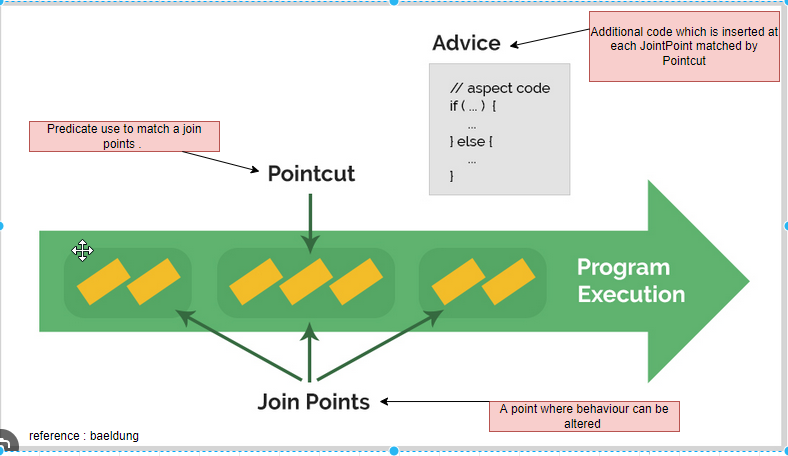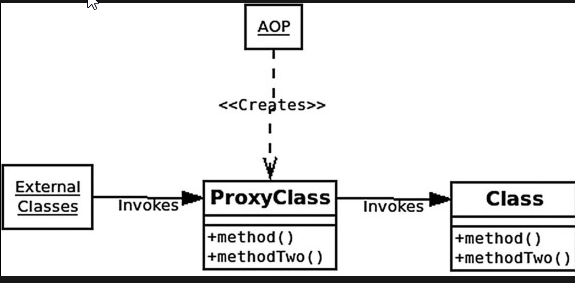From Chaos to Symphony: Embracing Spring AOP for Elegantly Orchestrated Code.
 Aditya Chaudhari
Aditya Chaudhari
Think of orchestrating an e-commerce platform as conducting a grand symphony. Each section of the orchestra - user management, inventory control, order processing, payment gateway, and security - must perform in harmony to deliver a melodious performance (a seamless shopping experience). However, ensuring synchrony while managing cross-cutting concerns like transaction control, security, logging, caching, event handling and error handling across these sections can feel like trying to conduct an orchestra while simultaneously playing every instrument.

This is where Spring AOP steps in, like a seasoned conductor. It helps streamline the performance, managing cross-cutting concerns independently, allowing each section to focus solely on its primary function. Aspects like transaction control or security become the rhythm section, providing a steady beat and form to the entire orchestra without overshadowing the melody.
Through this post, we'll explore how to conduct this grand symphony, leveraging Spring AOP to manage any enterprise software platform effectively, delivering a good experience not only to our customers but also to us who develop and manage the application in the backend.
Opening Remark
Remember, spring AOP is a programming paradigm, spring framework has provided a way to use this paradigm by providing related basic infrastructure code and guidelines.
As we build complex software, we often encounter tasks that span across different modules, like logging, security, and transaction management. Dealing with these "cross-cutting" concerns scattered throughout our codebase can be a headache, like juggling on a tightrope!
AOP comes to the rescue! It lets us modularize these cross-cutting concerns, making the code cleaner, more maintainable, and modular. Think of it as having a special assistant(like our music conductor ) handling common chores while we focus on the core business logic.
Spring Framework gracefully embraces AOP. It integrated AOP seamlessly to efficiently manage cross-cutting concerns in enterprise applications.
It's like having a reliable toolkit at our disposal, allowing us to address these issues seamlessly and avoid the pitfalls of tangled and messy code.
Aspect-oriented programming (AOP) is a programming paradigm that aims to increase modularity by allowing the separation of cross-cutting concerns. - wiki definition
Exploring the Basics of AOP
Terminologies: Join point, Advice, Pointcut, Aspect, Introduction, Target Object, Proxy, Weaving

Core Terminologies -
Aspect: Helpers handling cross-cutting concerns, like logging or transaction management. Aspect is a configuration which brings together pointcut and advice.
Join Points: The specific point during the program's execution where an aspect can be plugged in, similar to plugging a device into a socket.
Pointcut: A set of one or more join points where advice should be executed, like an instruction manual for the helper on when and where to help.
Advice: The action taken by an aspect at a particular join point, like what the helper does when stepping in to assist. This is actual code injected at desired location.
Other Terminologies -
Introduction: Allowing the addition of new methods or attributes to existing classes, giving the helper new skills for handling tasks.
Target Object: The object being advised by one or more aspects, the problem area or process that the helper is focused on.
Proxy: An object created after applying advice to a target object or before applying the result to the target object. This is the core of how AOP can do cross-cutting concerns.
Weaving: The process of applying aspects. In spring framework it's done at the runtime.
Introduction to cross-cutting concerns and the role of AOP in addressing them
Cross-cutting concerns are functionalities that impact various parts of an application. For example, think of authentication, caching, and error handling.
Imagine running a restaurant with various tasks like cooking, serving, and cleaning. It wouldn't be efficient for the chef to handle all the cleaning too, right? Similarly, with AOP, we can avoid duplicating code for these concerns in different parts of our application, ensuring a cleaner and more modular approach.
Reasons why every Spring developer should grasp the basics of AOP
The essence of AOP in Spring is not just beneficial, but important for us as developers. Here's why:
Primarily, AOP is the core mechanism driving many Spring features, including but not limited to transaction management, security, MVC handler mapping, Spring Boot's auto-configuration, Spring Cloud's circuit breakers, and Spring Data's data repositories. By mastering AOP, we're effectively unlocking the inner workings of Spring, its like understanding a car's engine mechanics.
Secondly, AOP champions modularity, allowing us to neatly isolate cross-cutting concerns from our main business logic. The upshot? A cleaner, more organized codebase that's straightforward to comprehend, test, debug, and maintain, much like a well-arranged workspace.
Lastly, the principle of code reusability is at the core of AOP. Write an aspect once, say for logging or security, and apply it across your application as needed. It keeps your code DRY (Don't Repeat Yourself), avoiding redundant tasks.
In essence, By sharpening our AOP skills, we ensure that we're not merely users of the Spring Framework, but craftsmen who fully grasp the potential of the tools at our disposal.
Aspect-Oriented Programming in the Spring Ecosystem
AspectJ is a full-scale complex AOP framework. To keep the simplicity of this post let's not dive deep into the AspectJ framework and let's just understand that Spring framework extends AspectJ's aspect-oriented programming features, creating a user-friendly AOP framework that seamlessly integrates with the Spring IoC container.
Spring's proxy-based approach
Spring uses a proxy-based approach to apply AOP. For every object that needs to be advised, a proxy object is created. This proxy object will contain the cross-cutting concern code and the business logic code. When a method on the proxy object is called, Spring AOP decides whether to execute the advice (cross-cutting concern code) before, after, or around the actual business method.

Ever noticed the discreet Proxy class just beneath the class you're debugging in a Spring application? That's AOP at work! AOP creates the proxy to manage specific aspects before your request reaches the actual class. It's like having a discreet assistant orchestrating the behind-the-scenes magic.
Simple AOP example
Problem Statement
In a traditional eCommerce application, actions such as viewing a product or placing an order are common tasks. Understanding when these events occur can provide valuable insights. However, sprinkling logging code throughout the business logic can make the codebase messy and violate the separation of concerns principle. So, how do we implement such logging cleanly and efficiently?
Solution
Step 1: Create Aspect Configuration
@Aspect
@Component
public class LoggingAspect {
private LoggerWrapper logger;
@Autowired
public LoggingAspect(LoggerWrapper logger) {
this.logger = logger;
}
//private static final Logger logger = LoggerFactory.getLogger(LoggingAspect.class);
@AfterReturning(pointcut = "execution(* com.adityatechinsights.springboot.examples.aop.aopspringbootexample.services.ProductService.getProduct(..))",
returning = "product")
public void afterProductView(JoinPoint joinPoint, Product product) {
logger.info("Product viewed: " + product.getName());
//CompletableFuture.runAsync(() -> logger.info("Product viewed: " + product.getName()));
}
@AfterReturning(pointcut = "execution(* com.adityatechinsights.springboot.examples.aop.aopspringbootexample.services.OrderService.placeOrder(..))",
returning = "order")
public void afterOrderPlaced(JoinPoint joinPoint, Order order) {
logger.info("Order placed: " + order.getId());
//CompletableFuture.runAsync(() -> logger.info("Order placed: " + order.getId()));
}
}
** product Service
@Service
public class ProductService {
@Autowired
private ProductRepository productRepository;
public Product getProduct(Long id) {
return productRepository.findById(id).orElse(null);
}
public Product saveProduct(Product product) {
return productRepository.save(product);
}
}
** order service
@Service
public class OrderService {
@Autowired
private OrderRepository orderRepository;
public Order placeOrder(Long productId) {
Order order = new Order();
order.setProductId(productId);
return orderRepository.save(order);
}
}
******************** OUTPUT ********************
main] o.s.b.w.embedded.tomcat.TomcatWebServer : Tomcat started on port(s): 8080 (http) with context path ''
main] .s.e.a.a.AopspringbootexampleApplication : Started AopspringbootexampleApplication in 3.573 seconds (process running for 4.005)
main] c.a.s.e.a.a.c.aspects.LoggingAspect : Product viewed: Test Product
main] c.a.s.e.a.a.c.aspects.LoggingAspect : Order placed: 1
In our LoggingAspect class, we are using some key annotations to set up the Aspect configuration:
@Aspect: This annotation is used to define an aspect. It tells Spring that theLoggingAspectclass will be used to apply advice to methods that match our point cut.@Component: This annotation allows Spring to automatically detect our aspect class during component scanning.
Step 2: Define Pointcuts and Advice
Next, we define what methods we want our Aspect to apply to (our pointcuts), and what code we want to execute when these methods are called (our advice):
@Pointcut: The pointcut expression is defined within theexecution()method. This method specifies the methods where the advice should apply. In this case, we are targetinggetProduct(..)method ofProductServiceandplaceOrder(..)method ofOrderService.
@AfterReturning: This annotation is an example of advice. It's what code should run after the targeted method returns successfully. This specific annotation also allows you to capture the returned object of the method execution. In this case, we are logging the product's name when a product is viewed and the order's id when an order is placed.
Here's an explanation of the methods in LoggingAspect:
afterProductView(JoinPoint joinPoint, Product product): This method is invoked aftergetProduct(..)successfully returns a product. TheJoinPointargument gives you information about the method execution that was advised (the method name, arguments etc.). TheProductargument represents the actual product that was returned by thegetProduct(..)method execution. We are logging the name of the product that was viewed.afterOrderPlaced(JoinPoint joinPoint, Order order): Similarly, this method is invoked afterplaceOrder(..)method successfully returns an order. We are logging the id of the order that was placed.
In above example we have used simple afterReturning advice , there are other types o advices as below .
@Before: Executes advice before a method is invoked.
@AfterReturning: Executes advice after a method successfully returns a value.
@AfterThrowing: Executes advice after a method throws an exception.
@After: Executes advice regardless of the method's outcome (success or exception).
@Around: Executes advice around a method, allowing full control over method invocation.
In this way, we can isolate the logging logic from the main business logic. This not only keeps the service classes clean and simple, but also promotes code reusability and modularity. All the while, AOP handles the complexity of determining when to invoke these advices.
You can also use xml based annotation, in the github code you ll get an example for xml based spring configuration for AOP.
Transaction Security and beyond the power of spring AOP
Spring's Aspect-Oriented Programming (AOP) capabilities extend far beyond the custom business operations or logging, playing a foundational role in Spring's transaction management, security, caching, and more.
Transaction Management
At the heart of Spring's transaction management lies AOP. Spring uses AOP to declaratively manage transaction boundaries via the @Transactional annotation or XML configurations. When a method is marked as @Transactional, a proxy ensures a transaction is started before the method execution and appropriately committed or rolled back afterward.
Security Management
Spring Security also heavily relies on AOP, enabling robust, method-level security using annotations such as @PreAuthorize, @PostAuthorize, and @Secured. These annotations trigger AOP to generate proxies, which handle the verification of security constraints before method invocation. This system neatly encapsulates security mechanisms, keeping them separated from core business logic and maintaining a clear, focused codebase.
Caching and Logging
Spring’s AOP is not just for transaction and security management. It is also instrumental in other areas like caching and logging. The @Cacheable annotation, for example, uses AOP to transparently add caching to applications, improving performance. Similarly, AOP can be used to standardize application logging, providing consistent, centralized control over log messages.
And More
From MVC exception handling to the management of concurrent sessions, Spring utilizes AOP as a backbone for many of its features.
In upcoming posts, we'll dive deeper into how you can leverage the power of Spring's AOP-driven modules - from transaction and security management to caching, logging, and beyond. Stay tuned for further posts!
Considering Performance: AOP's Impact and Spring's AOP Implementation
Aspect-Oriented Programming (AOP) presents both opportunities and challenges in performance management for web applications. Its power in modularizing cross-cutting concerns, like security and logging, often comes with a cost - increased overhead due to the creation of proxies and the weaving process.
However, Spring's AOP implementation often works better in terms of performance. Spring AOP uses runtime weaving which adds only a slight overhead.
Here's why runtime weaving can be better in terms of performance:
Selective Weaving: Since the weaving is done at runtime, you can make it more selective based on the real-time conditions or configurations. This can minimize the unnecessary overhead of applying aspects where they aren't needed.
Reduced Startup Time: Compile-time and load-time weaving may increase the startup time of your application, as the weaving has to be done before the application is executed. In the case of runtime weaving, this overhead is distributed throughout the execution, potentially making the startup quicker.
Limited Scope: Spring AOP is proxy-based and limits its operation to method execution join points. This means it only affects the methods where it is needed, thereby reducing the overall "scope" of the weaving process. This limits the performance overhead only to the parts of the application that actually need it.
Still, efficient use of AOP is crucial. Overuse of complex pointcuts can lead to performance issues. Instead, focusing on genuinely beneficial cross-cutting concerns and adopting compile-time weaving where possible can mitigate overheads.
Remember, AOP is a tool for enhancing code maintainability and readability. Its careful use, combined with regular profiling and performance monitoring, can help achieve a healthy balance between code structure and speed. Even with the potential performance impact, Spring's AOP remains a valuable tool for creating scalable, maintainable web applications.
DOs and DON'Ts of AOP in Spring Framework
When implementing Aspect-Oriented Programming (AOP) in the Spring framework, a measured approach guided by best practices can lead to more robust, maintainable code. Let's look at some of the crucial do's and don'ts.
Do's
Keep Aspects Cohesive: Just like classes, aspects should adhere to the single responsibility principle. Each aspect should manage a single cross-cutting concern to promote maintainability and reduce complexity.
Choose the Right Pointcut Expressions: Your pointcut expressions should be as precise as possible to avoid unintentional behavior. The Spring framework provides a rich set of designators that allows you to pinpoint the join points accurately.
Use Compile-time Validation: Wherever possible, use AspectJ's compile-time validation to discover misconfigurations early in the development cycle. This practice helps detect errors before they reach production.
Leverage Spring's 'proxy-target-class' Attribute: When you want your aspects applied to all methods of the class, including those called within the target class, consider using the 'proxy-target-class' attribute to create a CGLIB proxy instead of a JDK dynamic proxy.
Dont's
Avoid Overuse of AOP: While AOP is powerful, it can become a problem if overused. AOP can make code execution flow harder to understand and debug, especially when aspects modify the behavior of the targeted methods.
Don't Neglect Performance: Although Spring AOP's overhead is minimal, using too many aspects or complex pointcuts can impact performance. Regularly profile your application and watch out for performance impacts due to excessive AOP usage.
Don't Forget to Test Your Aspects: Aspects are part of your codebase and can introduce bugs like any other part of your application. Always test your aspects, preferably using integration tests, as they interact with other parts of your system.
Remember, like any other tool, AOP's effectiveness depends on how you use it. By adhering to these best practices and being mindful of the potential pitfalls, you can leverage AOP to write cleaner, more modularized code in the Spring framework.
Conclusion
In this introductory guide, we've tried to shed light on the power and flexibility of Aspect-Oriented Programming (AOP) and its important role within the Spring Framework. We've walked through the key concepts, highlighted some practical use cases, and given you a glimpse of how AOP forms the backbone of several crucial modules within the Spring ecosystem.
Given the focus on brevity, we've omitted the complexities of CGLIB proxies, JDK dynamic proxies, and variations in writing pointcuts and joinpoints. For a deeper exploration, delve into these powerful AOP components to enhance your understanding of Spring's AOP capabilities.
The goal of this post was to give an overview of the AOP landscape in Spring, with its potentials and pitfalls, and inspire you to explore further. Keep an eye out for our upcoming posts where we'll delve deeper into transactions, security, and caching.
Remember that AOP, while powerful, is a tool that should be handled with care.
Thank you for joining me on this journey to explore AOP, and I hope this post has given you a solid footing as you continue your exploration of Spring's Aspect-Oriented Programming. Until next time, Happy Coding!
references
https://link.springer.com/chapter/10.1007/978-1-4842-6144-6_5
https://www.baeldung.com/spring-aop
Subscribe to my newsletter
Read articles from Aditya Chaudhari directly inside your inbox. Subscribe to the newsletter, and don't miss out.
Written by

Aditya Chaudhari
Aditya Chaudhari
building efficient, scalable and maintainable enterprise e-commerce applications | Technical Architect | SAP Commerce Cloud (hybris) | Java | Spring | Mirakl